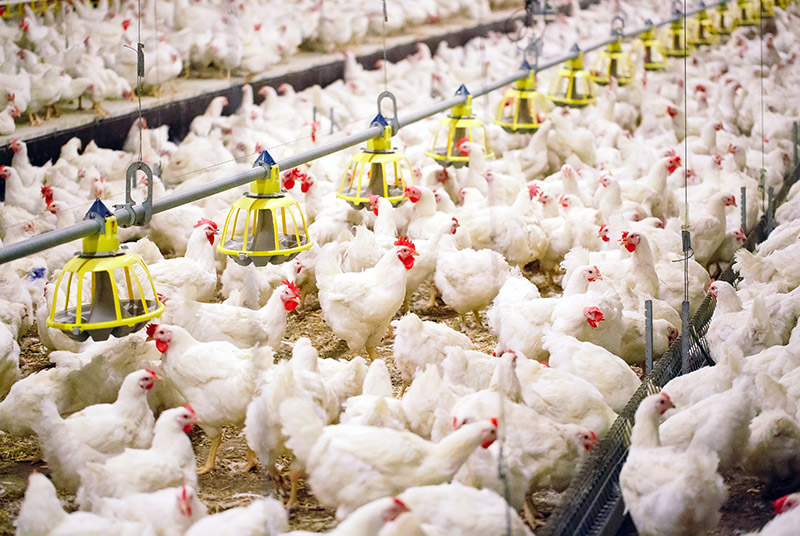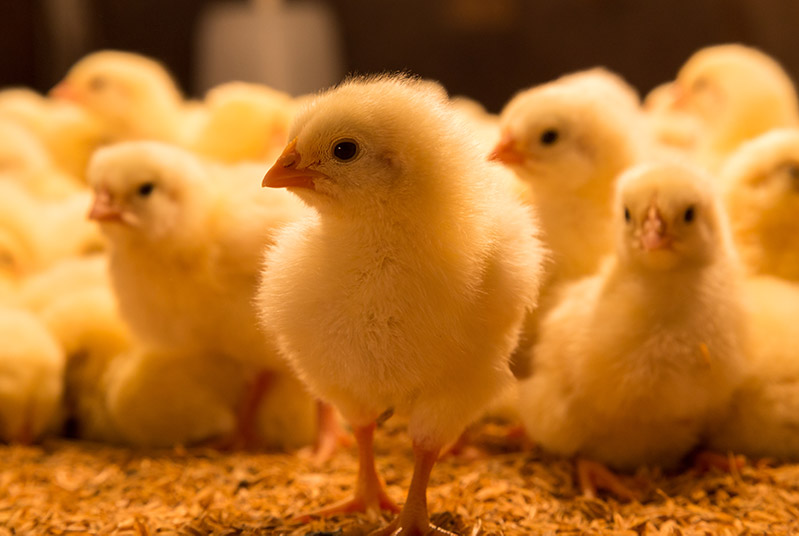Section | An Overview of Coccidiosis
Industry
Page 16 /
Coccidiosis, Coccidiostats, Human Health, and Antimicrobial Resistance
There are many diseases that impact the poultry industry, however, coccidiosis is likely the most costly on a yearly basis. The majority of the impact of this disease is due to subclinical effects (impacts on birds that are not yet showing clinical signs and symptoms), including the loss of performance and productivity1.
These costs specifically result from:
- Reduced feed conversion
- Reduced egg production
- Failure to thrive
- Treatment
- Prevention costs
Coccidiosis and Human Health
An additional concern with coccidiosis is the increased colonization of Clostridium perfringens, Salmonella typhimurium, and Salmonella enteritidis that occurs when a coccidia infection occurs2,3. When birds ingest coccidia oocysts, extensive and widespread damage to the gut can occur. When the gut’s defenses are down due to inflammation, invasion of bacteria (such as Salmonella), or increased proliferation of bacteria already present in the gut to harmful levels (as with Clostridium) can occur, causing secondary bacterial diarrhea and/or necrotic enteritis. This could also lead to concerns surrounding the transmission of disease to humans through egg and poultry consumption.
Coccidiostats and Antimicrobial Resistance
There are many concerns surrounding coccidiosis and antimicrobial resistance. Bacteria are developing ways to survive in the presence of the drugs (antimicrobials) that were designed to kill them. Inappropriate, excessive, incomplete, or unwarranted use of antimicrobials can contribute to the development and spread of antimicrobial resistance in bacteria. In order to minimize the advancement of resistance, which could lead to a post-antimicrobial era, where these drugs are no longer effective at treating bacterial diseases, everyone who uses antimicrobials — physicians, the public, farmers, veterinarians — must do their part to use them appropriately.
A significant portion of antimicrobials sold for use in the poultry industry are used to control coccidiosis. Coccidiostats are feed additives that are used to prevent coccidiosis (microbes) by inhibiting or killing coccidia; the widespread use of these products4 has led to antimicrobial resistance, which reduces the effectiveness of these drugs. In fact, development of resistance in coccidia in all eleven coccidiostats has been described suggesting that these antimicrobials need to used appropriately to maintain their effectiveness, and that alternatives such as non-antimicrobial feed additives, environmental cleanliness, and vaccination need to be explored.
Listen as we discuss this topic with Dr. Mark Malpass, a microbiologist with Trouw Nutrition, and his global perspective on where the Canadian poultry industry is headed, as well as Dr. Martine Boulianne, as she discusses her research on chick health and antimicrobial resistance.
)
Antimicrobial Use Reduction in the Canadian Poultry Industry
The Canadian poultry industry has also taken a leading role in crafting The Antimicrobial Use Reduction Strategy:
- Phase I and II of the strategy have eliminated preventative use of Category I (2017) and Category II (2018) antimicrobials
- The industry intends to further eliminate the prophylactic use of Category III antimicrobials, which will impact the use of bacitracin
See how antimicrobial medications are categorized:
Categorization of Antimicrobials
It is important for producers to understand that the voluntary removal of Category III antimicrobials (or drugs such as bacitracin or others that have low importance to human health) does not mean a transition to a Raised Without Antibiotics model. It also does not mean that birds that require treatment with antimicrobials are no longer allowed. Preventative use of antimicrobials can reduce the number of medications available to use when antimicrobial resistance develops.
For an overview on some of the research being done in Canada on reducing antimicrobial use, check out this website:
Chair in Poultry Research: Reduction of Antibiotics
)
Regulatory Changes
In the past, the use of certain antimicrobials have contributed to increased and enhanced growth, particularly in broiler operations. Since December 1st, 2018, when regulations surrounding antimicrobial use ended the use of antimicrobial medications as growth-promoting agents.
The availability and effect of antimicrobials have made them an important tool for maintaining optimal flock health. However, the reliance on these tools has had unintended consequences, and their impact is being threatened. As a result, it is necessary to understand how to prevent and control coccidiosis through management and antimicrobial alternatives to ensure flocks are able to manage with a reduced reliance on antimicrobial agents.
Poultry Health Today has developed a video resource with some lessons learned on transitioning away from blanket antimicrobial therapy, and how management practices can be adjusted to improve immunity and optimize production: Life without antibiotics: Field lessons learned the hard way.
The Chicken Farmers of Canada has developed an overview of antimicrobial resistance, and some information on their reduction strategy, which can be found here. They have also curated a list of farmer and government resources on addressing this high priority issue.
References:
- Jordan, B., G. Albanese, and L. Tensa. 2020. Coccidiosis in Chickens (Gallus gallus). Taylor & Francis Group, Boca Raton, FL, USA.
- Collier, .T., C.L. Face, A.M. Payne, D.B. Anderson, P. aiser, R.I. Mackie, and H.R. Gaskins. 2008. Coccidia-induced mucogenesis promotes the onset of necrotic enteritis by supporting Clostridium perfringens growth. Vet Immunol Immunopathol. 122:104-115.
- Qin, Z., A. Arakawa, E. Baba, T. Fukata, and K. Sasai. 1996. Effect of Eimeria tenalla infection on the production of Salmonella enteritidis-contaminated eggs and susceptibility of laying hens to S. enteritidis infection. Avian Dis. 40:361-367.
- Nesse, L.L., A.M. Bakke, T. Eggen, K. Hotel, M. Kaldhusdal, E. Ringo, S.P. Yasdankhah, E.J. Lock, R.E. Olsen, R. Ornsrud, and A. Krogdahl. 2019. The risk of development of antimicrobial resistance with the use of coccidiostats in poultry diets. European Journal of Nutrition and Food Safety. 11:40-43.